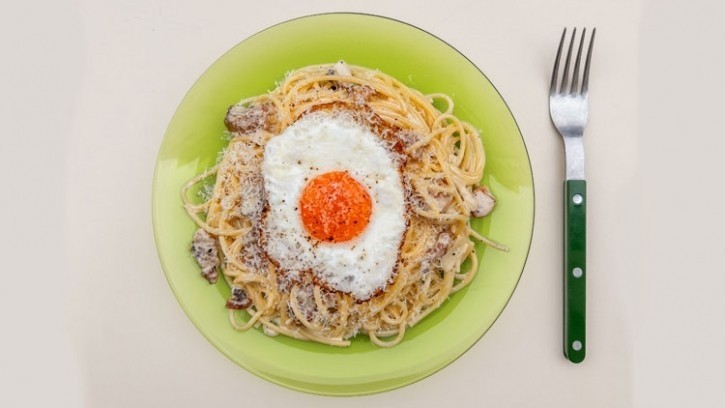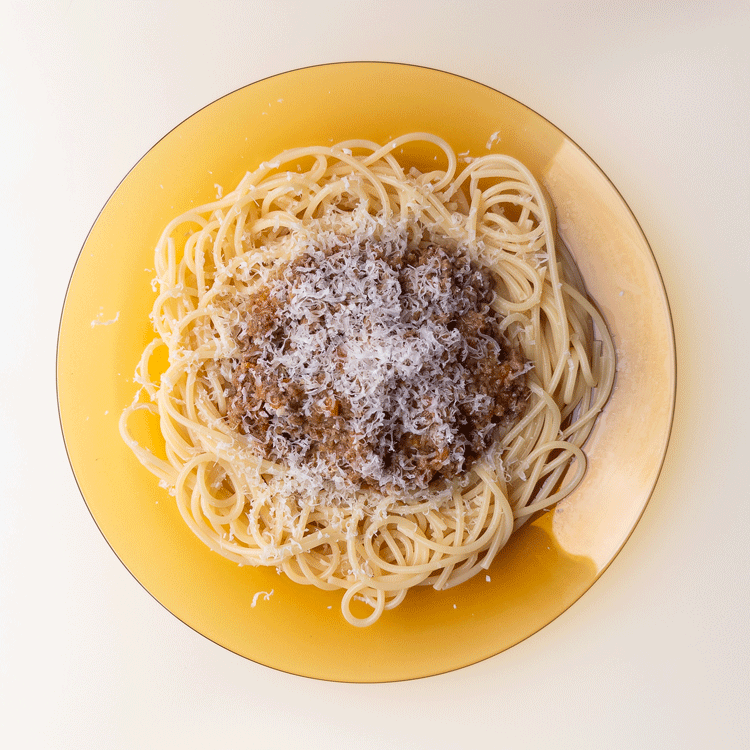Spaghetti junction: how Britain became a hotbed of creative Italian cooking

Like many chefs, Dean Parker loves Italian food culture: its local, seasonal roots; the shared, family-style meals; its thrifty, resourceful DNA.
“Most Italian ragouts are so thoughtful. There’s no wastage. The pig gets slaughtered, everything is used,” says Parker, whose Glasgow restaurant, Celentano’s, in its lasagne fritte or pappardelle with beef ragout, makes that inspiration clear.
Yet this is no orthodox Italian restaurant. Named after groundbreaking musician, Adriano Celentano, Parker’s restaurant charts a distinctive path in its smoked cod doughnuts with kimchi, barbecued trout, wilted greens and seaweed butter, or whipped ‘nduja, cultured cream and radishes. Celentano’s handmade pasta dishes are creative. For example, linguine with cod cheeks, mussels, wild garlic and fennel. Its affogato comprises malted barley gelato, dark chocolate mousse and a rye crumb, served with cold-brew coffee.
A former head chef at Robin Gill’s Sorella, Parker, who cooked in southern Italy for a month prior to that role, follows the local, seasonal MO of Italian food by – given he is in Glasgow - sourcing almost exclusively in Scotland and Britain (olive oil is one exception). Naturally, this encouraged him to use Asian ferments - which provide flavour and acid without using lemons - and to treat Italian food as a creative jumping-off point, rather than a fixed destination.
Celentano’s mindset is Italian. Hence its whole animal butchery, homemade charcuterie, dishes designed for convivial sharing and its antipasti-primi-secondi menu structure. But this “Italian-inspired” restaurant’s dishes are, “not traditional in any sense”, says Parker.
Bending the rules
In that fresh, self-confident treatment of Italian cooking, Celentano’s is not alone. From London’s Manteca (dubbed, “gloriously ‘inauthentic’”, by critic, Tom Parker Bowles), to Edinburgh’s Tipo, Britain has a growing wave of restaurants which are both reverent of Italian food and put their own stamp on it. Historically, authenticity, a contentious concept, was seen as the hallmark of quality in British-Italian food. Now, Manteca serves a crab cacio e pepe. Dishes are being reinvented. Rules bent. Deliciousness is its own justification.
Despite serving fresh pastas, gnudi, tiramisu and novel savoury zeppole doughnuts, Tipo does not call itself ‘Italian’. Co-owner, chef Stuart Ralston, who took considerable inspiration from New York’s Italian restaurants, “didn’t want to pretend we are doing authentic Italian cooking”, nor end-up in spats with, “keyboard warriors calling me out if bigoli [a type of tubular pasta] is never served with truffles or whatever regional mistake we may make”.
“I love and have always been able to make great pasta,” says Ralston, whose brother, Scott, is Tipo’s head chef. But equally, Ralston, “never wanted to be limited”, by how a specific pasta is served in Italy.
A decade ago, you might logically have predicted a growth in restaurants which, like Soho’s Bocca di Lupo or Lancashire’s La Locanda, strive to cook Italian dishes as they are cooked in Italy. Britain’s maturing interest in Italian food seemed to demand more regionally specific Italian cooking.
Instead, the surge is in restaurants such as Pazzo (meaning, crazy), which opened last year. Part of Bristol’s Bianchi Group, whose restaurants include its eponymous flagship trattoria and the rustic, northern Italian-orientated, Cotto, Pazzo, is an energetic, “creative playground”, says director Dominic Borel, where chef Ben Harvey, Borel’s cousin, can, “challenge the old ways”, in dishes of smashed cucumber, Tropea onion and Calabrian chilli honey, or fried pork hash with aubergine and pomegranate molasses.
Pasta dishes come in a traditional format, such as spaghetti with garlic, chilli and olive oil, or diners can add a Pazzo twist. Chicken Milanese and rocket, in that case. Pazzo’s ‘loco’ carbonara can be topped with crispy pork belly and a pancetta-clad poached egg.
“We get bored easily,” says Borel, whose Italian family on Lake Como, find all this, “a bit cheeky. But we often cater for friends in the village and they have a lovely time – and almost forget we’re messing with tradition”.
"Obvious rage bait"
That cross-pollination between Italian, British and global cuisines has a long history in the UK. The Italian-owned, lasagne-and-chips high street cafes that proliferated in Britain after WWII, for example, have recently inspired Peckham’s Café Britaly. Its menu ranges from an upmarket fish finger sandwich to a cult carbonara with cream, topped with a fried egg. Evening Standard critic, Jimi Famurewa, called that carbonara, “obvious rage bait” (the addition of cream is anathema to Italian food purists), and also, “a rib-squeezing hug of pure comfort”.
In the 2010s, Jamie Oliver was serving British flatbreads (ie. pizza), at Union Jacks, while the now Michelin-starred Luca, was one of the first restaurants to publicly flag its intent to examine, “British seasonal ingredients through an Italian lens”. Using a similar methodology, award-winning gastropub, the Unruly Pig, proudly identifies as ‘Britalian’, a still useful portmanteau.
More recently, Britain has created its own take on Neapolitan-style pizza, using sourdough bases and often UK-inspired toppings. In 2019, online magazine, Foodism, asked: “Is there such a thing as ‘London pizza’?” (Answer: a qualified, yes).
The reasons why British restaurants deviate from the Italian norm vary. At Cardiff’s Bacareto, half its Venetian-style cicchetti snacks are meat-free. The team was keen to do something creative, inclusive and, “as gentle as possible on the environment”, says co-founder, Becca Thomas. Using familiar, often seasonal British ingredients in those cicchetti (leek and cheddar arancino with burnt leek salt; coley, samphire and capers on focaccia), also creates a familiar ‘in’ for guests new to the cicchetti concept. This is important.
UK restaurants deep-diving into Italian regional cooking face several barriers. In recent years, for instance, rarer gourmet ingredients have become harder-to-find and, like most high-end imports, far more expensive. Do that detective work, says Newcastle chef, Nick Grieves, and you still have to overcome the fact that often British people do not see the ‘value’ in pared-back, peasant-style Italian dishes.
As a former River Café chef, Grieves adores such cooking, but: “The simplicity would definitely hold back Italian regional cooking in the mass market. The general public are not going to see a piece of mozzarella and braised greens on Instagram and think, ‘oh, that looks amazing’.”
The monthly New York Italian event, Vinny’s, which Grieves runs at his restaurant, Ophelia, is a different matter: “It sells 80, 90 covers in two hours. No menu, no big push. Just an Instagram post and it’s full.” The cooking is fastidious. Key Italian ingredients are sourced with great care. But this is a cool, fun night out – loud music, pink lighting, red-and-white tablecloths – that revolves around accessible plates of clam linguine, chicken parmigiana and meatballs in red sauce. “It’s pasta. Who doesn’t like pasta?” asks Grieves, rhetorically.
Occasionally, Grieves drops more obscure dishes (say, a buttered pasta flavoured with fermented anchovy extract, colatura di alici), but it is Vinny’s colourful, cheese-forward dishes which fly out. The formula, says Grieves, is: “Making something everyone knows, doing it a little better than the next person, but not complicating things too much.”
Harking back to the golden age of dining
‘New’, sociable, easily understood and bathed in a halo of timeless glamour (think: Sinatra and the Rat Pack, Mad Men), it is easy to see why New York Italian restaurants are enjoying a moment, right now. The Guardian critic, Grace Dent, described The Dover in Mayfair as harking back to a, “golden age of dining”. Louis, an imminent Manchester opening from the Permanently Unique Group, will pair fresh pastas and classic cocktails with nightly live music. With influential New York Italian restaurant, Carbone, currently planning its arrival in London, expect interest in this world of veal Parmesan, spicy rigatoni vodka and lobster ravioli to grow.
Bocca di Luppo owner Jacob Kenedy is steeped in the minutiae of Italian regional cooking. But the chef is also a big fan of Luca, Café Britaly and all manner of “experimental, fusion” Italian restaurants: “There’s room for both in this world.”
And in Italy, too. In attempting to produce faithful versions of historic Italian dishes, Kenedy is keenly aware that, rather than working from a definitive rulebook, he has to reconcile differing views - within Italy, a region, between neighbouring towns - about how dishes should be cooked: “Often I’ll be cooking in a way people from the region find acceptable, or even nice if I’m lucky, but not always.”
The British tend to view Italian food as monolithic, and the (online) outrage which greets deviations from traditional recipes as representing the Italian national line. In fact, says Rome-based cook and writer, Rachel Roddy, author of An A-to-Z Of Pasta (Penguin): “If I have learned one thing, it is that for every sacred rule, the absolute opposite is also true.”
Similarly, there is a traditional, highly regional sphere of Italian cooking. But running alongside that, says Roddy, there is “as much innovation and dynamic thought”. Be that academic Alberto Grandi exploding the mythology around Italian food or the cutting-edge restaurants profiled in Laura Lazzaroni’s 2021 book, The New Cucina Italiana (Rizzoli International).
That Italian food is simultaneously evolving in Paris, Buenos Aires or London is, you could argue, very in the spirit of contemporary Italian cooking. It is certainly testament to Italian food’s incredible popularity. Even compared to French cuisine, says Grieves: “People are not scared of Italian food.”
In 2023, Mintel calculated the UK pizza and Italian restaurant market to be worth £5.6bn; predicting it would grow 25% by 2028. The discourse around Italian food may get heated at times, but on one point there is no dispute: Britain loves Italian food.



























